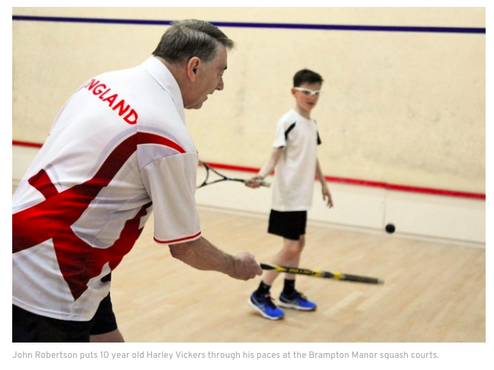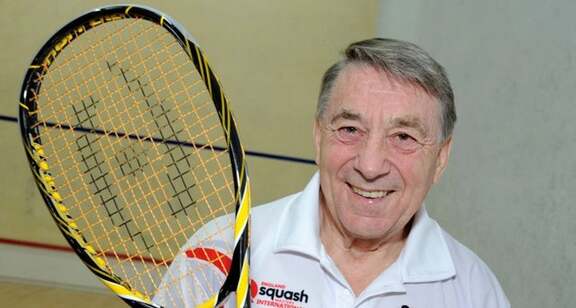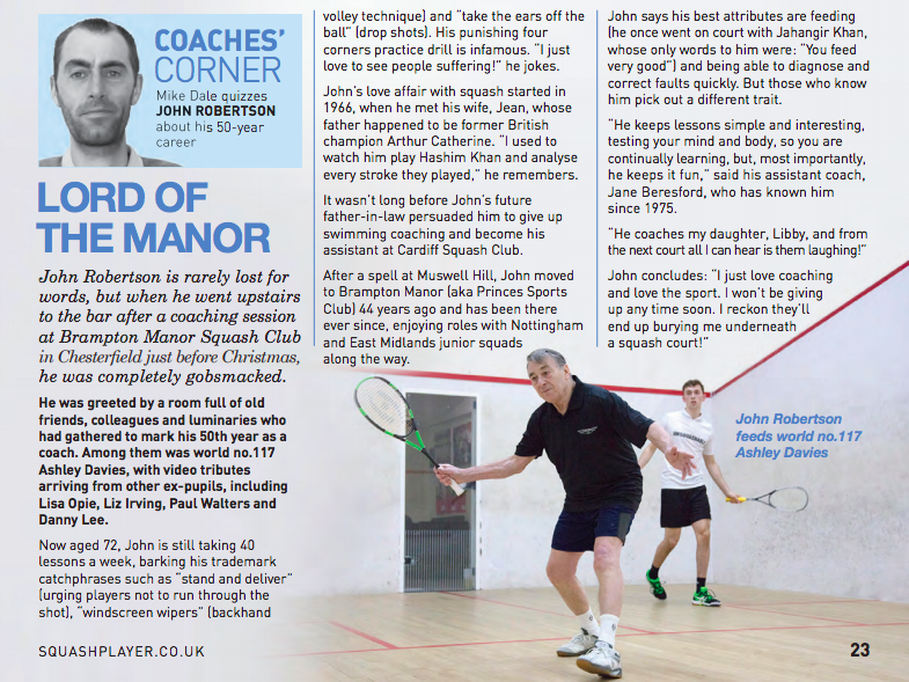
UK-Racketball interview John Robertson, "Robbo", one of the founders of Racketball
Racketball was introduced to the UK in the early 80’s by Tony Gathercole who at the time was one of Slazenger’s top reps, a good tennis and squash player and worked for EMI who owned around 25 squash clubs in the UK.
Tony Gathercole saw racketball as a way of boosting court usage during the day. Along with 8 other EMI coaches (including John Robertson his son in law) they decided to make a concerted effort to bring this new game “Racketball” to the UK. The enterprise was sponsored by Slazanger who developed the “green” ball and who initially provided the rackets for the EMI clubs. The rackets were slightly smaller than the ones being used in the US at the time; the ball was nowhere near as fast and probably bounced a similar amount to the blue balls of today. The rules for the US game were also adapted to incorporate the lines on a squash court of which there were an abundance in England.
The reason for racketball’s popularity and the benefits that the introduction of the sport had for squash clubs was the same back in the 80’s as it is today. With the bouncy “green” ball the game was perfect for anyone looking for a medium intensity sociable workout away from the boredom of the gym and was quickly taken up. The game has now spread out from the original 8 clubs to what we have today a sport played all over the country and still spreading.
At its peak John Roberson (Robbo) believed that “The Manor” in Ilkeston (host venue in the 2011 UK-RB Series) and “Brampton Manor” in Chesterfield had around 250 and 500 racketball players respectively. At the start he claimed there was a similar feeling by traditional squash players as there is today, that racketball should not be taking up time on squash courts and with a negative feeling towards many of the players (especially women) that these were squash not racketball clubs. Looking back, “Robbo” said it always made him laugh because the so called big squash fans who would get on his back and grumble about the racketball being played are now the sport’s biggest takers. “Once they got dodgy knees, backs or hips they had to sack in the squash but they were massive lovers of the clubs and once they started playing racketball they got hooked just the same as they had with squash all those years ago. The game that they had despised breathed new life into them, they’re back having competitive matches, big rallies and loving racketball.”
Racketball was introduced to the UK in the early 80’s by Tony Gathercole who at the time was one of Slazenger’s top reps, a good tennis and squash player and worked for EMI who owned around 25 squash clubs in the UK.
Tony Gathercole saw racketball as a way of boosting court usage during the day. Along with 8 other EMI coaches (including John Robertson his son in law) they decided to make a concerted effort to bring this new game “Racketball” to the UK. The enterprise was sponsored by Slazanger who developed the “green” ball and who initially provided the rackets for the EMI clubs. The rackets were slightly smaller than the ones being used in the US at the time; the ball was nowhere near as fast and probably bounced a similar amount to the blue balls of today. The rules for the US game were also adapted to incorporate the lines on a squash court of which there were an abundance in England.
The reason for racketball’s popularity and the benefits that the introduction of the sport had for squash clubs was the same back in the 80’s as it is today. With the bouncy “green” ball the game was perfect for anyone looking for a medium intensity sociable workout away from the boredom of the gym and was quickly taken up. The game has now spread out from the original 8 clubs to what we have today a sport played all over the country and still spreading.
At its peak John Roberson (Robbo) believed that “The Manor” in Ilkeston (host venue in the 2011 UK-RB Series) and “Brampton Manor” in Chesterfield had around 250 and 500 racketball players respectively. At the start he claimed there was a similar feeling by traditional squash players as there is today, that racketball should not be taking up time on squash courts and with a negative feeling towards many of the players (especially women) that these were squash not racketball clubs. Looking back, “Robbo” said it always made him laugh because the so called big squash fans who would get on his back and grumble about the racketball being played are now the sport’s biggest takers. “Once they got dodgy knees, backs or hips they had to sack in the squash but they were massive lovers of the clubs and once they started playing racketball they got hooked just the same as they had with squash all those years ago. The game that they had despised breathed new life into them, they’re back having competitive matches, big rallies and loving racketball.”

could do to change things and get membership numbers back on track.
“We did massive leaflet drops” was the first thing he said, “We targeted people for during the day sessions to get them on the courts and ran introductory courses to get them going. It was amazing to see a new sport spring up so quickly, to get 500 people playing at Brampton Manor was fantastic.”
When asked why he thought clubs were struggling today he was just as quick to voice his opinions. “One of the big problems with clubs back in the 80s was that managers tried to make too much money without putting enough back. When a profit was made it was taken out rather than put to use maintaining the club. This resulted in lots of clubs becoming run down and as the facilities deteriorate the membership numbers fall. This is why the top clubs today are the members clubs, the ones that invest back in all the money they make. Edgbaston, Nottingham, Hallamshire all have top facilities and are completely owned by the members.”
“Never underestimate the impact that social events have on a club, the big advantage that squash and racketball have over gyms is how social they are, you don’t just go to a box (in most cases a very nice box with Jacuzzis and a swimming pool), exercise and then go home, you make good friends and the clubs end up having a big impact on your life. At some gyms people will have been going 3 years and still not know anything about the other people in the changing rooms, this doesn’t happen with squash, by the nature of the game you have to interact with the people around you. If clubs can tap into this and build a social scene around the members this can have a massive impact on their future.”
Robbo said he thought Pete Goodings at the Manor is on the right lines. “It doesn’t matter who you are if you want a game Pete will pick up his racket and go on court. A top club pro should breath, eat and sleep the game, virtually live at the club (literally in the case of Pete Goodings) and at every opportunity promote the club and the game. As well as having the right (dedicated) club pro the clubs also need to market themselves in the right way to attract new people to the club, it then becomes the club pros job to keep them interested.”
From my own observations the problem that many clubs find is that when money becomes tight the first thing to go is the subsidises for social events, money to attract a good club pro (and keep him motivated) and the marketing budget. This means that if clubs aren’t careful they end up being sucked into a negative spiral which is probably an all too familiar story for the sport today. Less income results in less money available for maintenance and marketing which again results in less income and so forth. How to get out of the hard times is the real test but putting as much profit back in is what John Robertson claims is the best way to try and weather the storm.
Robbo still coaches at Brampton Manor now running racketball and junior sessions, but does it for all for fun, he says to watch out for his next crop of junior’s to rival his old stars (Mark Chaloner, Jason Nicol and Fiona Geeves, to name only a few). Like a true squash addict he just can’t leave the game alone.
Robbo has been coaching for over 50 years, follow this link to the Derbyshire Times article
https://www.derbyshiretimes.co.uk/sport/after-50-years-coaching-squash-brampton-mans-england-career-taking-54357
“We did massive leaflet drops” was the first thing he said, “We targeted people for during the day sessions to get them on the courts and ran introductory courses to get them going. It was amazing to see a new sport spring up so quickly, to get 500 people playing at Brampton Manor was fantastic.”
When asked why he thought clubs were struggling today he was just as quick to voice his opinions. “One of the big problems with clubs back in the 80s was that managers tried to make too much money without putting enough back. When a profit was made it was taken out rather than put to use maintaining the club. This resulted in lots of clubs becoming run down and as the facilities deteriorate the membership numbers fall. This is why the top clubs today are the members clubs, the ones that invest back in all the money they make. Edgbaston, Nottingham, Hallamshire all have top facilities and are completely owned by the members.”
“Never underestimate the impact that social events have on a club, the big advantage that squash and racketball have over gyms is how social they are, you don’t just go to a box (in most cases a very nice box with Jacuzzis and a swimming pool), exercise and then go home, you make good friends and the clubs end up having a big impact on your life. At some gyms people will have been going 3 years and still not know anything about the other people in the changing rooms, this doesn’t happen with squash, by the nature of the game you have to interact with the people around you. If clubs can tap into this and build a social scene around the members this can have a massive impact on their future.”
Robbo said he thought Pete Goodings at the Manor is on the right lines. “It doesn’t matter who you are if you want a game Pete will pick up his racket and go on court. A top club pro should breath, eat and sleep the game, virtually live at the club (literally in the case of Pete Goodings) and at every opportunity promote the club and the game. As well as having the right (dedicated) club pro the clubs also need to market themselves in the right way to attract new people to the club, it then becomes the club pros job to keep them interested.”
From my own observations the problem that many clubs find is that when money becomes tight the first thing to go is the subsidises for social events, money to attract a good club pro (and keep him motivated) and the marketing budget. This means that if clubs aren’t careful they end up being sucked into a negative spiral which is probably an all too familiar story for the sport today. Less income results in less money available for maintenance and marketing which again results in less income and so forth. How to get out of the hard times is the real test but putting as much profit back in is what John Robertson claims is the best way to try and weather the storm.
Robbo still coaches at Brampton Manor now running racketball and junior sessions, but does it for all for fun, he says to watch out for his next crop of junior’s to rival his old stars (Mark Chaloner, Jason Nicol and Fiona Geeves, to name only a few). Like a true squash addict he just can’t leave the game alone.
Robbo has been coaching for over 50 years, follow this link to the Derbyshire Times article
https://www.derbyshiretimes.co.uk/sport/after-50-years-coaching-squash-brampton-mans-england-career-taking-54357
For the full article follow this link... http://www.squashplayer.co.uk/workshop/2017/SP171-23(CoachesCorner)2.pdf


